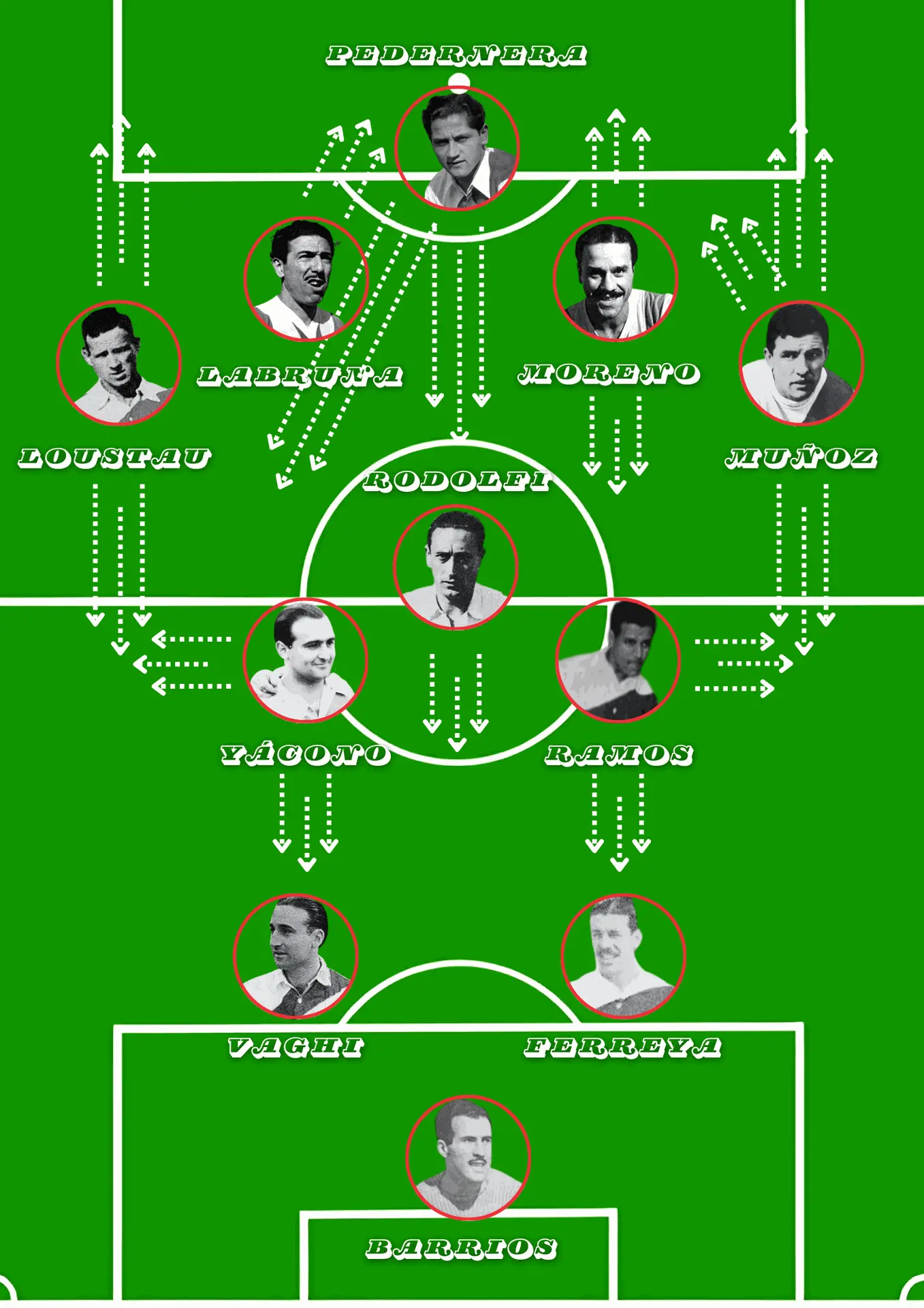One of the best offensive teams
An impressive attacking line
The famous team of La Maquina is the most famous team in the history of Argentine football. They dominated Argentine football in the 1940s thanks to a superb attacking line.
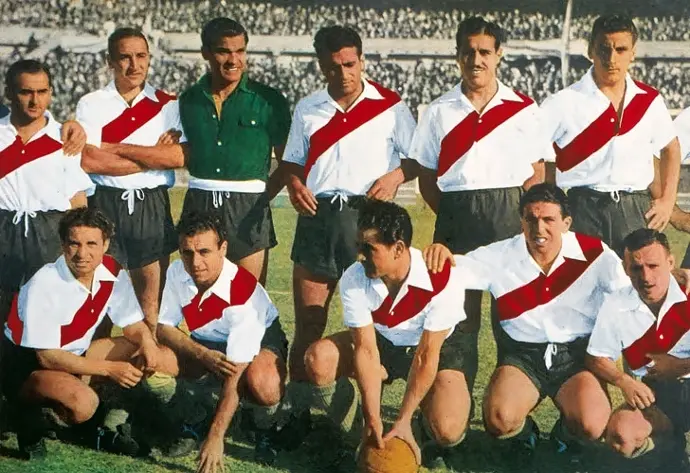
Legendary players
With Manuel Fleitas Solich as coach, the River Plate team will take a new direction. Playing in a 2-3-5 system, with wingers making defensive returns and a false 9 in the person of Adolfo Pedernera, the club has a nice balance and relies on attacking individuals to make the difference.
At goalkeeper, we find Julio Barrios, the Uruguayan goalkeeper. In front of him, there are mainly defenders Ricardo Vaghi and Avelino Cadilla the Uruguayan, with sometimes the appearance of Luis Antonio Ferreyra, who will gradually become a starter. In midfield, we find Norberto Yácono, José Ramos and Bruno Rodolfi. This very strong trio will aim to provide support during the defensive phases and numbers in the offensive phase.
The attack is the jewel of River Plate. First of all, as a right winger, we find Juan Carlos Muñoz, a small right winger with devastating dribbles. With his low center of gravity, he is formidable one-on-one and eliminates his opponents with great ease. His other asset is his great quality of centering, he was recognized in the country as one of the best in this exercise as well as for free kicks. A song was also made in his honor "Sale el sol, sale la luna, centro de Muñoz, gol de Labruna!" As a left winger, we find Félix Loustau, a whimsical dribbler, who is known for his fast and hard-hitting style. It is said that during a match where there was a large crowd of police officers who were on horseback to prevent the many people from entering the field, one of the horses made a police officer stagger and rushed onto the field. Félix Loustau would have seen the horse, passed the ball under his legs, he too would have gone on all fours under the horse and then continued with a dribble on one of the defenders of the opposing team before delivering a magnificent cross.
As inside-right, we find José Manuel Moreno, the star of the team and best player of the club. Tall, muscular, he was a very complete striker, knowing how to both defend and attack with excellence. Skilled with both feet, he had an overpowering shot and an exceptional head game. Amadeo Carrizo, who will be the team's starting goalkeeper from 1954 says that Moreno is among the 4 best players in the history of Argentina.
As inside-left we find Angel Labruna, a striker with incredible vertical jump. With great composure, he is known as one of the greatest finishers in the history of Argentine football and one of the most loyal players to his club, playing from 8 to 41 years old for River Plate.
The center forward, who is more of a false 9 in his way of playing is Adolfo Pedernera. Very good in his positioning, he has an exceptional vision and an incredible quality of pass, he is one of the players with one of the most beautiful offensive arsenals in history. He is the link between all the players in the attack and midfield.
The team was nicknamed "The Knights of Anguish" by its supporters and "La Maquina" by a journalist from the newspaper El Grafico as the players seemed to know each other on the field. This River Plate team was one of the most beautiful to watch play due to its very offensive and whimsical game.
A trophy raid from the start
The year 1941 was the first of this Maquina which would already win the Argentine championship. With 44 points, they finished first, 4 points ahead of San Lorenzo and they scored 75 goals in 30 games, for 35 conceded, the best defense in the championship.
This year 1941 would be one of all successes, since in addition to winning the championship, the team won the Copa Aldao 6-1 against Nacional Montevideo, a hat-trick from Labruna and a hat-trick from Roberto D'Alessandro, a legendary striker of the club, who was a little withdrawn during the Maquina. The club also won the Copa Adrián C. Escobar 1-0 against Club Atlético Huracán, again a goal by Roberto D'Alessandro. Finally, the club wins the Copa Ibarguren 3-0 against Newell's Old Boys with goals from Labruna, Pedernera and D'Alessandro.
D'Alessandro finishes the season with 10 goals in 17 games played. A very good result for a substitute especially considering the importance of the goals scored. Julio Barrios finishes the season with 26 games played, 9 clean sheets and only 28 goals conceded. Pedernera has 13 goals in 21 games. Juan Carlos Muñoz has 6 goals in 14 games. Jose Manuel Moreno 14 goals in 29 games. Carlos Peucelle has 4 goals in 15 games.
The five fingers of the machine finally completed
At the beginning of 1942, the River Plate club recruited one of the key players of La Maquina, Félix Loustau. Carlos Peucelle left the club and retired after 10 years of good and loyal service.
With a similar team, River Plate won the Argentine championship again and did even better. 46 points in the championship, for 79 goals scored and 37 conceded. The attack was incredible with a twirling Félix Loustau. They finished once again ahead of San Lorenzo and their 40 points. And this time the Argentine club had the best attack and the best defense in the championship.
Where the club would show its full domination was in the Copa Ibarguren 1942 where they won 7-0 against Liga Cordobesa. Double from Deambrossi, double from Loustau, a goal from Labruna, Pedernera and Moreno.
Roberto D'Alessandro finishes the season with 8 goals in 8 games, while Aristobulo Deambrossi has 8 goals in 28 games. Félix Loustau, who is only 19 years old, has 3 goals in 11 games. Juan Carlos Muñoz has 5 goals in 20 games. Angel Labruna has 15 goals in 28 games. José Manuel Moreno has 10 goals in 28 games. The star of this season is undoubtedly Adolfo Pedernera, who in his role as playmaker is monstrously effective, scoring 23 goals in 24 games.
A first blank year
In 1943, D'Alessandro left the club. River Plate had a blank season. Finishing runner-up in Argentina behind their rival, Boca Juniors. River Plate finished the season with 44 points, 74 goals scored and 38 conceded. It was still a superb season.
Now Félix Loustau was an undisputed starter as he finished the season with 11 goals in 27 games. Angel Labruna had a superb season with 23 goals in 23 games. Juan Carlos Muñoz played 17 games for 4 goals. José Manuel Moreno was in a playmaker role and scored 6 goals in 22 games. Adolfo Pedernera had 15 goals in 26 games. At the goalkeeper position, there was a change with Julio Barrios being moved to the bench in favor of Eduardo Lettieri.
A second blank year
The year 1944 was a copy-paste, the club continued to captivate spectators but no title at the end of the year. Second in the championship, again behind Boca Juniors, the club finished the championship with 44 points, 68 goals scored for 43 goals conceded. A youngster joined the squad without playing, Amadeo Carrizo, the future legend of Argentine football. It was the Peruvian goalkeeper José Eusebio Soriano who was the starter. Another youngster appeared, Néstor Rossi, who was 19 years old.
Adolfo Pedernera played even more as a playmaker and false nine, he only scored 6 goals in 27 games. José Manuel Moreno only played 5 games for 4 goals. Juan Carlos Muñoz played 26 games for 9 goals. Angel Labruna was the offensive leader of this season with 25 goals in 30 games. Félix Loustau has 8 goals in 28 games.
Back to success
River Plate returned to success in 1945 after two blank seasons. Despite the departure of José Manuel Moreno, Ángel Labruna finished as the league's top scorer with 25 goals. The balance and positional play between him and Pedernera was now automatic and the team worked perfectly. River Plate first won the league with 46 points, 4 points more than Boca Juniors. They scored 66 goals and conceded only 34. Once again, they had the best defense in the league.
The club won the Copa Aldao again, 2-1 against Penarol in the first leg in Uruguay, then another 3-2 victory in the return leg at home. Labruna scored a double in the first leg and a hat-trick in the return leg. The Argentine striker was unstoppable and had perhaps the best season of his career. In total, he finished the season with 30 goals in 31 games. Juan Carlos Muñoz has 4 goals in 14 games. Félix Loustau has 10 goals in 29 games. Adolfo Pedernera has 11 goals in 29 games. A little gem also makes an appearance, a certain Alfrédo Di Stéfano.
La Maquina's Worst Year
The 1946 season was the worst for River Plate, finishing in 3rd place in the league, behind San Lorenzo and Boca Juniors. River Plate had 41 points, 59 goals for 34 conceded. José Eusebio Soriano was still a starter in goal, Néstor Rossi was a starter in defense with Vaghi. Offensively, Pedernera had a pretty good season, 9 goals in 24 games. José Manuel Moreno was back and had a good little season with 8 goals in 13 games. Juan Carlos Muñoz had 6 goals in 27 games. Angel Labruna had 15 goals in 27 games. Félix Loustau had 9 goals in 30 games. Di Stéfano did not play the season with the first team.
The emergence of Di Stéfano and the end of a reign
River Plate came back strong in the 1947 season where they won the championship. Adolfo Pedernera left the club. Hector Grisetti was the new starting goalkeeper for Boca Juniors. In 30 games, he conceded 37 goals and kept 7 clean sheets. With this new goalkeeper, and the emergence of Di Stéfano who finished top scorer in the championship with 27 goals, River Plate finished 1st in the Argentine championship with 48 points, 22 wins, 4 draws, 4 losses, 90 goals scored for 37 conceded. Certainly the second best year of La Maquina and also the last of River Plate's domination.
The club also won the Copa Aldao 4-3 in the first leg against Nacional Montevideo in Uruguay then won 3-1 at home. Hat-trick from Labruna and a goal from Di Stefano in the first leg, then hat-trick from Hugo Reyes in the return leg.
Di Stéfano finished the season with 28 goals in 32 games and established himself as the team's new best player. José Manuel Moreno scored 10 goals in 28 games. Juan Carlos Muñoz did not play all season. Félix Loustau scored 13 goals in 30 games. Labruna had 16 goals in 18 games. Hugo Reyes had 11 goals in 32 games.
The club gradually lost its legends and its domination of the championship before regaining this power in the 50s, but the club would never regain the charm that La Maquina and its legendary players had.
Trophies :
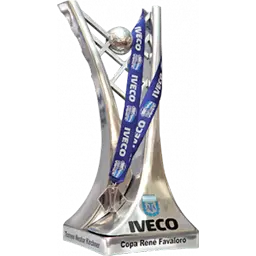
Argentinian League x4
- 1941
- 1942
- 1945
- 1947

Vice-Champion Argentinian League x2
- 1943
- 1944
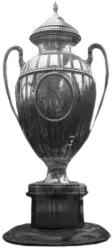
Copa Aldao x3
- 1941
- 1945
- 1947
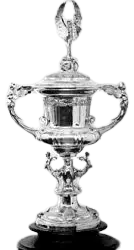
Copa Adrián C. Escobar x1
- 1941
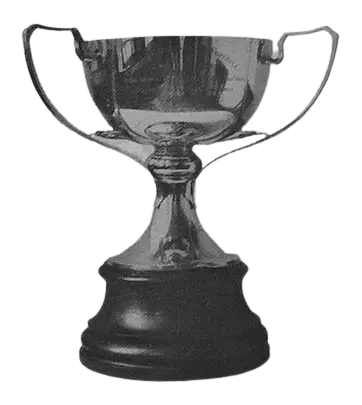
Copa Ibarguren x2
- 1941
- 1942
